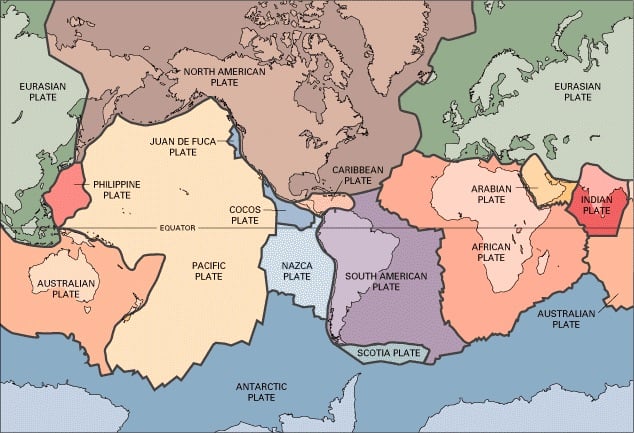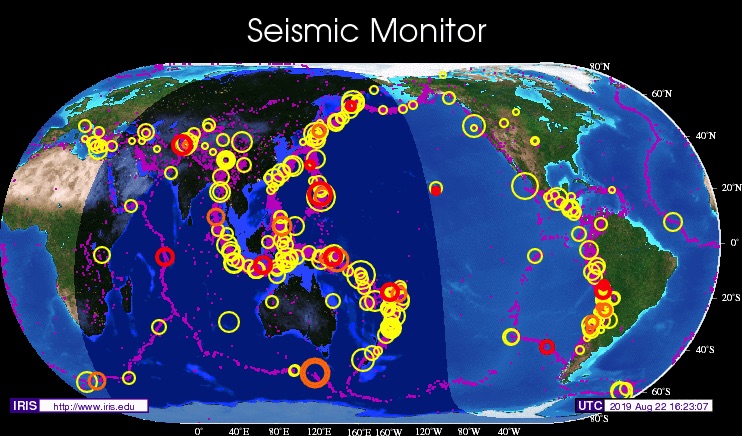Earthquakes happen every day all over the world, along both tectonic plate edges and interiors. Earthquakes occur along faults, which are fractures between blocks of rock that allow the blocks to move relative to one another. Faults are caused by the bumping and sliding that plates do and are more common near the edges of the plates.
Plates, Motion, Faults, Energy Release
The Earth's crust (the outer layer of the planet) is made up of several pieces called tectonic plates and most earthquakes occur along their edges. The plates under the oceans are called oceanic plates. Plates that are not under the ocean are continental plates. The plates are moved around by the motion of a deeper part of the earth (the mantle) that lies underneath the crust, and by the weight of oceanic plates that pulls them down below oceanic plates. These plates are always moving apart, bumping, or sliding past each other at about the same speed that your fingernails grow. Earthquakes usually occur where two plates are running into each other or sliding past each other.


Earthquakes Can Happen Along Intraplate Faults
Earthquakes can occur along faults far from the edges of plates. Although these earthquakes are much less common, they are due to the same forces that cause earthquakes along plate boundaries.
Types of Faults
Faults are defined by the kind of motion that happens where they are. Normal faults show cracks where one block of rock is sliding down and away from another block of rock. These faults usually occur in areas where the crust is very slowly stretching or where two plates are pulling away from each other. A normal fault is defined by the hanging wall (a term that comes from mining) moving down relative to the footwall (where the miner would stand), which is moving up.
Normal Fault: The "footwall" is on the "upthrown" side of the fault, moving upwards. The "hanging wall" is on the "downthrown" side of the fault, moving downwards.
Reverse Faults
Reverse faults are formed where the Earth’s crust is under compression. They also occur where the crust is folding up because it's being compressed by another plate pushing against it. At these faults, one block of rock is sliding underneath another block or one block is being pushed up over the other. A reverse fault is defined by the hanging wall moving up relative to the footwall, which is moving down.
Reverse Fault: This time, the "footwall" is on the "downthrown" side of the fault, moving downwards, and the "hanging wall" is on the "upthrown" side of the fault, moving upwards. When the hanging wall is on the upthrown side, it "hangs" over the footwall.
Strike-slip Faults
Strike-slip faults lie between two sides of the crust that slide past each other and are common in places like California where the Pacific Plate is moving northwest relative to the North American Plate. In a pure strike-slip fault, there is no motion up or down along the fault. The well-known San Andreas fault is predominantly strike-slip.
Strike-slip Fault: The motion shows a left-lateral strike-slip fault. No matter which side of the fault you are on, the other side is moving to the left. For a right lateral strike-slip fault (not shown), no matter which side of the fault you are on, the other side is moving to the right.
Fun Fact: The Keweenaw Peninsula—home to Michigan Tech and UPSeis, is also known for the massive slip fault that marks our landscape. The Keweenaw Fault is the result of activity more than one billion years ago and presents no current danger. In other words, don’t fear the fault!